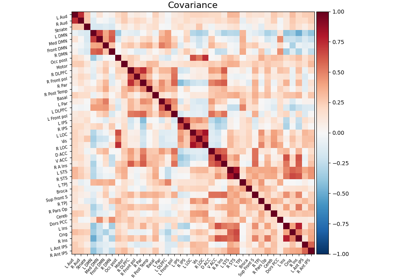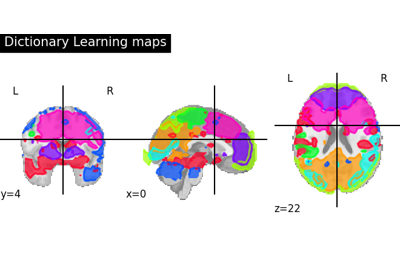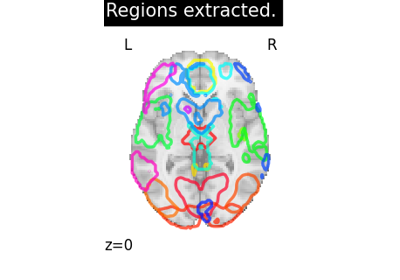Note
This page is a reference documentation. It only explains the class signature, and not how to use it. Please refer to the user guide for the big picture.
nilearn.maskers.NiftiMapsMasker¶
- class nilearn.maskers.NiftiMapsMasker(maps_img=None, mask_img=None, allow_overlap=True, smoothing_fwhm=None, standardize=False, standardize_confounds=True, high_variance_confounds=False, detrend=False, low_pass=None, high_pass=None, t_r=None, dtype=None, resampling_target='data', keep_masked_maps=True, memory=None, memory_level=0, verbose=0, reports=True, cmap='CMRmap_r', clean_args=None, **kwargs)[source]¶
Class for extracting data from Niimg-like objects using maps of potentially overlapping brain regions.
NiftiMapsMasker is useful when data from overlapping volumes should be extracted (contrarily to
nilearn.maskers.NiftiLabelsMasker).Use case: summarize brain signals from large-scale networks obtained by prior PCA or ICA.
Note
Inf or NaN present in the given input images are automatically put to zero rather than considered as missing data.
For more details on the definitions of maps in Nilearn, see the Extraction of signals from regions: NiftiLabelsMasker, NiftiMapsMasker section.
- Parameters:
- maps_img4D niimg-like object or None, default=None
See Input and output: neuroimaging data representation. Set of continuous maps. One representative time course per map is extracted using least square regression.
- mask_img3D niimg-like object, optional
See Input and output: neuroimaging data representation. Mask to apply to regions before extracting signals.
- allow_overlap
bool, default=True If False, an error is raised if the maps overlaps (ie at least two maps have a non-zero value for the same voxel).
- smoothing_fwhm
floatorintor None, optional. If smoothing_fwhm is not None, it gives the full-width at half maximum in millimeters of the spatial smoothing to apply to the signal.
- standardize{‘zscore_sample’, ‘zscore’, ‘psc’, True, False}, default=False
Strategy to standardize the signal:
'zscore_sample': The signal is z-scored. Timeseries are shifted to zero mean and scaled to unit variance. Uses sample std.'zscore': The signal is z-scored. Timeseries are shifted to zero mean and scaled to unit variance. Uses population std by calling defaultnumpy.stdwith N -ddof=0.'psc': Timeseries are shifted to zero mean value and scaled to percent signal change (as compared to original mean signal).True: The signal is z-scored (same as option zscore). Timeseries are shifted to zero mean and scaled to unit variance.False: Do not standardize the data.
- standardize_confounds
bool, default=True If set to True, the confounds are z-scored: their mean is put to 0 and their variance to 1 in the time dimension.
- high_variance_confounds
bool, default=False If True, high variance confounds are computed on provided image with
nilearn.image.high_variance_confoundsand default parameters and regressed out.- detrend
bool, optional Whether to detrend signals or not.
- low_pass
floatorintor None, default=None Low cutoff frequency in Hertz. If specified, signals above this frequency will be filtered out. If None, no low-pass filtering will be performed.
- high_pass
floatorintor None, default=None High cutoff frequency in Hertz. If specified, signals below this frequency will be filtered out.
- t_r
floatorintor None, default=None Repetition time, in seconds (sampling period). Set to None if not provided.
- dtypedtype like, “auto” or None, default=None
Data type toward which the data should be converted. If “auto”, the data will be converted to int32 if dtype is discrete and float32 if it is continuous..
- resampling_target{“data”, “mask”, “maps”, None}, default=”data”
Defines which image gives the final shape/size.
"data"means that the atlas is resampled to the shape of the data if needed"mask"means that themaps_imgand images provided tofit()are resampled to the shape and affine ofmask_img"maps"means themask_imgand images provided tofit()are resampled to the shape and affine ofmaps_imgNonemeans no resampling: if shapes and affines do not match, aValueErroris raised.
- keep_masked_maps
bool, optional If True, masked atlas with invalid maps (maps that contain only zeros after applying the mask) will be retained in the output, resulting in corresponding time series containing zeros only. If False, the invalid maps will be removed from the trimmed atlas, resulting in no empty time series in the output.
Deprecated since version 0.10.2: The ‘True’ option for
keep_masked_mapsis deprecated. The default value will change to ‘False’ in 0.13, and thekeep_masked_mapsparameter will be removed in 0.15.- memoryNone, instance of
joblib.Memory,str, orpathlib.Path Used to cache the masking process. By default, no caching is done. If a
stris given, it is the path to the caching directory.- memory_level
int, default=0 Rough estimator of the amount of memory used by caching. Higher value means more memory for caching. Zero means no caching.
- verbose
int, default=0 Verbosity level (0 means no message).
- reports
bool, default=True If set to True, data is saved in order to produce a report.
- cmap
matplotlib.colors.Colormap, orstr, optional The colormap to use. Either a string which is a name of a matplotlib colormap, or a matplotlib colormap object. default=”CMRmap_r” Only relevant for the report figures.
- clean_args
dictor None, default=None Keyword arguments to be passed to
cleancalled within the masker. Withinclean, kwargs prefixed with'butterworth__'will be passed to the Butterworth filter. .. versionadded:: 0.12.0- kwargsdict
Keyword arguments to be passed to functions called within the masker. Kwargs prefixed with ‘clean__’ will be passed to
clean. Withinclean, kwargs prefixed with ‘butterworth__’ will be passed to the Butterworth filter (i.e., clean__butterworth__).Deprecated since version 0.12.0.
Use
clean_argsinstead!It is recommended to pass parameters to use for data cleaning via
dictto theclean_argsparameter.Passing parameters via “kwargs” is mutually exclusive with passing cleaning parameters via
clean_args.
- Attributes:
- clean_args_
dict Keyword arguments to be passed to
cleancalled within the masker. Withinclean, kwargs prefixed with'butterworth__'will be passed to the Butterworth filter.- clean_kwargs_dict
Keyword arguments to be passed to functions called within the masker. Kwargs prefixed with ‘clean__’ will be passed to
clean. Withinclean, kwargs prefixed with ‘butterworth__’ will be passed to the Butterworth filter (i.e., clean__butterworth__).Deprecated since version 0.12.0.
Use
clean_argsinstead!It is recommended to pass parameters to use for data cleaning via
dictto theclean_argsparameter.Passing parameters via “kwargs” is mutually exclusive with passing cleaning parameters via
clean_args.- maps_img_
nibabel.nifti1.Nifti1Image The maps mask of the data.
- mask_img_A 3D binary
nibabel.nifti1.Nifti1Imageor None. The mask of the data. If no
mask_imgwas passed at masker construction, thenmask_img_isNone, otherwise is the resulting binarized version ofmask_imgwhere each voxel isTrueif all values across samples (for example across timepoints) is finite value different from 0.- memory_joblib memory cache
- n_elements_
int The number of overlapping maps in the mask. This is equivalent to the number of volumes in the mask image.
Added in version 0.9.2.
- clean_args_
Notes
If resampling_target is set to “maps”, every 3D image processed by transform() will be resampled to the shape of maps_img. It may lead to a very large memory consumption if the voxel number in maps_img is large.
- __init__(maps_img=None, mask_img=None, allow_overlap=True, smoothing_fwhm=None, standardize=False, standardize_confounds=True, high_variance_confounds=False, detrend=False, low_pass=None, high_pass=None, t_r=None, dtype=None, resampling_target='data', keep_masked_maps=True, memory=None, memory_level=0, verbose=0, reports=True, cmap='CMRmap_r', clean_args=None, **kwargs)[source]¶
- fit(imgs=None, y=None)[source]¶
Prepare signal extraction from regions.
- Parameters:
- imgs
listof Niimg-like objects or None, default=None See Input and output: neuroimaging data representation. Image data passed to the reporter.
- yNone
This parameter is unused. It is solely included for scikit-learn compatibility.
- imgs
- fit_transform(imgs, y=None, confounds=None, sample_mask=None)[source]¶
Prepare and perform signal extraction.
- Parameters:
- imgs3D/4D Niimg-like object
See Input and output: neuroimaging data representation. Images to process. If a 3D niimg is provided, a 1D array is returned.
- yNone
This parameter is unused. It is solely included for scikit-learn compatibility.
- confounds
numpy.ndarray,str,pathlib.Path,pandas.DataFrameorlistof confounds timeseries, default=None This parameter is passed to
nilearn.signal.clean. Please see the related documentation for details. shape: (number of scans, number of confounds)- sample_maskAny type compatible with numpy-array indexing, default=None
shape = (total number of scans - number of scans removed)for explicit index (for example,sample_mask=np.asarray([1, 2, 4])), orshape = (number of scans)for binary mask (for example,sample_mask=np.asarray([False, True, True, False, True])). Masks the images along the last dimension to perform scrubbing: for example to remove volumes with high motion and/or non-steady-state volumes. This parameter is passed tonilearn.signal.clean.Added in version 0.8.0.
- Returns:
- signals
numpy.ndarray Signal for each voxel. Output shape for :
3D images: (number of elements,) array
4D images: (number of scans, number of elements) array
- signals
- generate_report(displayed_maps=10)[source]¶
Generate an HTML report for the current
NiftiMapsMaskerobject.Note
This functionality requires to have
Matplotlibinstalled.- Parameters:
- displayed_maps
int, orlist, orndarray, or “all”, default=10 Indicates which maps will be displayed in the HTML report.
If
"all": All maps will be displayed in the report.
masker.generate_report("all")
masker.generate_report([6, 3, 12])
- If an
int: This will only display the first n maps, n being the value of the parameter. By default, the report will only contain the first 10 maps. Example to display the first 16 maps:
- If an
masker.generate_report(16)
- displayed_maps
- Returns:
- reportnilearn.reporting.html_report.HTMLReport
HTML report for the masker.
- get_metadata_routing()¶
Get metadata routing of this object.
Please check User Guide on how the routing mechanism works.
- Returns:
- routingMetadataRequest
A
MetadataRequestencapsulating routing information.
- get_params(deep=True)¶
Get parameters for this estimator.
- Parameters:
- deepbool, default=True
If True, will return the parameters for this estimator and contained subobjects that are estimators.
- Returns:
- paramsdict
Parameter names mapped to their values.
- inverse_transform(region_signals)[source]¶
Compute voxel signals from region signals.
Any mask given at initialization is taken into account.
- Parameters:
- signals1D/2D
numpy.ndarray Extracted signal. If a 1D array is provided, then the shape should be (number of elements,). If a 2D array is provided, then the shape should be (number of scans, number of elements).
- signals1D/2D
- Returns:
- img
nibabel.nifti1.Nifti1Image Transformed image in brain space. Output shape for :
1D array : 3D
nibabel.nifti1.Nifti1Imagewill be returned.2D array : 4D
nibabel.nifti1.Nifti1Imagewill be returned.
- img
- set_fit_request(*, imgs='$UNCHANGED$')¶
Request metadata passed to the
fitmethod.Note that this method is only relevant if
enable_metadata_routing=True(seesklearn.set_config). Please see User Guide on how the routing mechanism works.The options for each parameter are:
True: metadata is requested, and passed tofitif provided. The request is ignored if metadata is not provided.False: metadata is not requested and the meta-estimator will not pass it tofit.None: metadata is not requested, and the meta-estimator will raise an error if the user provides it.str: metadata should be passed to the meta-estimator with this given alias instead of the original name.
The default (
sklearn.utils.metadata_routing.UNCHANGED) retains the existing request. This allows you to change the request for some parameters and not others.Added in version 1.3.
Note
This method is only relevant if this estimator is used as a sub-estimator of a meta-estimator, e.g. used inside a
Pipeline. Otherwise it has no effect.- Parameters:
- imgsstr, True, False, or None, default=sklearn.utils.metadata_routing.UNCHANGED
Metadata routing for
imgsparameter infit.
- Returns:
- selfobject
The updated object.
- set_inverse_transform_request(*, region_signals='$UNCHANGED$')¶
Request metadata passed to the
inverse_transformmethod.Note that this method is only relevant if
enable_metadata_routing=True(seesklearn.set_config). Please see User Guide on how the routing mechanism works.The options for each parameter are:
True: metadata is requested, and passed toinverse_transformif provided. The request is ignored if metadata is not provided.False: metadata is not requested and the meta-estimator will not pass it toinverse_transform.None: metadata is not requested, and the meta-estimator will raise an error if the user provides it.str: metadata should be passed to the meta-estimator with this given alias instead of the original name.
The default (
sklearn.utils.metadata_routing.UNCHANGED) retains the existing request. This allows you to change the request for some parameters and not others.Added in version 1.3.
Note
This method is only relevant if this estimator is used as a sub-estimator of a meta-estimator, e.g. used inside a
Pipeline. Otherwise it has no effect.- Parameters:
- region_signalsstr, True, False, or None, default=sklearn.utils.metadata_routing.UNCHANGED
Metadata routing for
region_signalsparameter ininverse_transform.
- Returns:
- selfobject
The updated object.
- set_params(**params)¶
Set the parameters of this estimator.
The method works on simple estimators as well as on nested objects (such as
Pipeline). The latter have parameters of the form<component>__<parameter>so that it’s possible to update each component of a nested object.- Parameters:
- **paramsdict
Estimator parameters.
- Returns:
- selfestimator instance
Estimator instance.
- set_transform_request(*, confounds='$UNCHANGED$', imgs='$UNCHANGED$', sample_mask='$UNCHANGED$')¶
Request metadata passed to the
transformmethod.Note that this method is only relevant if
enable_metadata_routing=True(seesklearn.set_config). Please see User Guide on how the routing mechanism works.The options for each parameter are:
True: metadata is requested, and passed totransformif provided. The request is ignored if metadata is not provided.False: metadata is not requested and the meta-estimator will not pass it totransform.None: metadata is not requested, and the meta-estimator will raise an error if the user provides it.str: metadata should be passed to the meta-estimator with this given alias instead of the original name.
The default (
sklearn.utils.metadata_routing.UNCHANGED) retains the existing request. This allows you to change the request for some parameters and not others.Added in version 1.3.
Note
This method is only relevant if this estimator is used as a sub-estimator of a meta-estimator, e.g. used inside a
Pipeline. Otherwise it has no effect.- Parameters:
- confoundsstr, True, False, or None, default=sklearn.utils.metadata_routing.UNCHANGED
Metadata routing for
confoundsparameter intransform.- imgsstr, True, False, or None, default=sklearn.utils.metadata_routing.UNCHANGED
Metadata routing for
imgsparameter intransform.- sample_maskstr, True, False, or None, default=sklearn.utils.metadata_routing.UNCHANGED
Metadata routing for
sample_maskparameter intransform.
- Returns:
- selfobject
The updated object.
- transform(imgs, confounds=None, sample_mask=None)[source]¶
Apply mask, spatial and temporal preprocessing.
- Parameters:
- imgs3D/4D Niimg-like object
See Input and output: neuroimaging data representation. Images to process. If a 3D niimg is provided, a 1D array is returned.
- confounds
numpy.ndarray,str,pathlib.Path,pandas.DataFrameorlistof confounds timeseries, default=None This parameter is passed to
nilearn.signal.clean. Please see the related documentation for details. shape: (number of scans, number of confounds)- sample_maskAny type compatible with numpy-array indexing, default=None
shape = (total number of scans - number of scans removed)for explicit index (for example,sample_mask=np.asarray([1, 2, 4])), orshape = (number of scans)for binary mask (for example,sample_mask=np.asarray([False, True, True, False, True])). Masks the images along the last dimension to perform scrubbing: for example to remove volumes with high motion and/or non-steady-state volumes. This parameter is passed tonilearn.signal.clean.Added in version 0.8.0.
- Returns:
- signals
numpy.ndarray Signal for each voxel. Output shape for :
3D images: (number of elements,) array
4D images: (number of scans, number of elements) array
- signals
- transform_single_imgs(imgs, confounds=None, sample_mask=None)[source]¶
Extract signals from a single 4D niimg.
- Parameters:
- imgs3D/4D Niimg-like object
See Input and output: neuroimaging data representation. Images to process.
- confoundsCSV file or array-like, default=None
This parameter is passed to
nilearn.signal.clean. Please see the related documentation for details. shape: (number of scans, number of confounds)- sample_maskAny type compatible with numpy-array indexing, default=None
shape = (total number of scans - number of scans removed)for explicit index (for example,sample_mask=np.asarray([1, 2, 4])), orshape = (number of scans)for binary mask (for example,sample_mask=np.asarray([False, True, True, False, True])). Masks the images along the last dimension to perform scrubbing: for example to remove volumes with high motion and/or non-steady-state volumes. This parameter is passed tonilearn.signal.clean.Added in version 0.8.0.
- Returns:
- signals
numpy.ndarray Signal for each voxel. Output shape for :
3D images: (number of elements,) array
4D images: (number of scans, number of elements) array
- signals
Examples using nilearn.maskers.NiftiMapsMasker¶

Classification of age groups using functional connectivity

Comparing connectomes on different reference atlases

Computing a connectome with sparse inverse covariance

Extracting signals of a probabilistic atlas of functional regions

Group Sparse inverse covariance for multi-subject connectome

Regions extraction using dictionary learning and functional connectomes

Regions Extraction of Default Mode Networks using Smith Atlas
